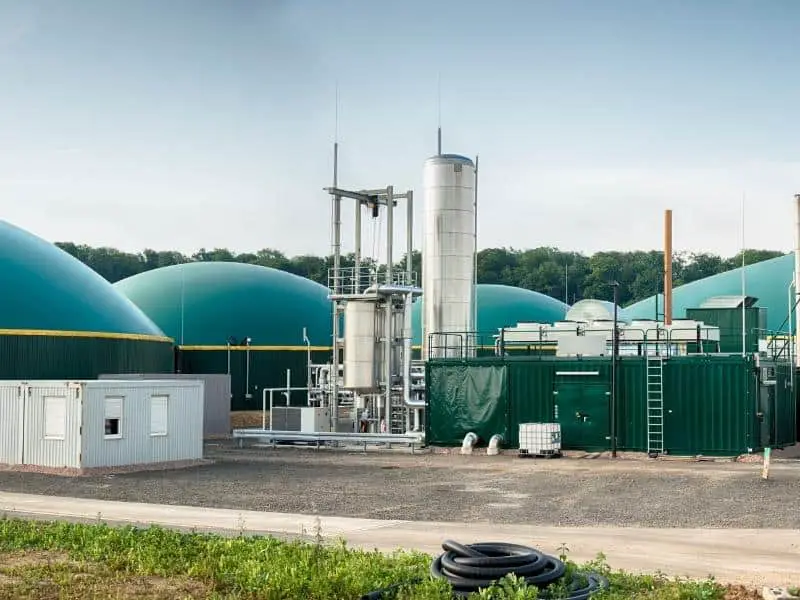Whether you’ve been reading about biogas and you’re considering getting a biodigester, or you’re just curious about how the process of producing biogas works, we’ve got you covered.
Biogas production is a process known as methane fermentation, consisting of four stages of anaerobic decomposition. These four stages are hydrolysis, acidogenesis, acetogenesis, and methanogenesis. It depends on the symbiosis between acid- and methane-producing bacteria.
The various stages of this process are fascinating, and there are all sorts of exciting details, so let’s dive right in.
We will examine the following topics:
- The Symbiosis Between Acid- And Methane-Producing Bacteria
- The Four Stages Of Methane Fermentation
- How The Biogas Production Process Is Practically Applied
Biogas production is not that complicated once you understand the basic biochemistry, which we will briefly cover.

How Does Symbiosis Between Bacteria Produce Biogas?
Bacteria digest biomass in the absence of oxygen (anaerobically) to produce biogas. These processes occur in many natural and artificial environments, such as the intestines of humans and animals, swamps, and sewage effluent ponds.
The symbiosis between bacterial species is necessary for biogas formation. Acid-producing bacteria create the ideal conditions for methane-producing bacteria. Methane-producing bacteria feed on the waste of the acid-producers, maintaining ideal conditions for them.
Different assemblages of bacteria carry out the individual steps in breaking down the biomass into biogas, which have different requirements and act in symbiosis with each other.
Fermentation
Hydrolyzing and fermenting organisms attack carbohydrates, lipids, and proteins in the biomass to produce acetate, hydrogen, and various amounts of volatile fatty acids such as butyrate and propionate.
Some of these bacteria are strict anaerobes such as Clostridia, Bacteriocides, and Bifidobacteria, while others are facultative anaerobes such as Streptococcus and Enterobacteria.
The volatile fatty acids are converted into acetate and hydrogen by acetogenic bacteria. Lastly, two groups of methanogenic bacteria use acetate or hydrogen and carbon dioxide to produce methane, the main ingredient in biogas.
Because the hydrolyzing and acid-producing bacteria produce food for the next groups of bacteria, they benefit them.
Similarly, because the acetogenic and methanogenic bacteria use these breakdown products, they maintain ideal conditions for the hydrolyzing and acid-producing bacteria.
What Are The Four Stages Of Biogas Production?
We will examine the four stages of biogas production: hydrolysis, acidogenesis, acetogenesis, and methanogenesis.
1. Hydrolysis In The Production Of Biogas
Biomass is usually made up of large organic molecules: carbohydrates, fats, and proteins. During hydrolysis, fermentative bacteria break these down into sugars, fatty acids, peptides, and amino acids, respectively, as well as by-products such as hydrogen and acetate.
Methanogenic bacteria can use hydrogen and acetate, but most of the molecules produced by this step are too large. They will need to be broken down further before being used by methanogenic bacteria.
2. Acidogenesis In The Production Of Biogas
The next step of anaerobic digestion involves acidogenic bacteria. They break down the sugars, fatty acids, and amino acids from the previous step into acids such as acetic acid, propionic acid, butyric acid, and alcohols, ammonia, hydrogen, carbon dioxide, and hydrogen sulfide.
Therefore, these fermentative bacteria create an acidic environment in the digestion environment, which the methanogenic bacteria require.
3. Acetogenesis In The Production Of Biogas
Acetogenesis is the process whereby acetate, a derivative of acetic acid, is created by acetogenic organisms from carbon and energy sources.
During this stage, acetogenic microbes catabolize most breakdown products from acidogenesis into acetic acid, hydrogen, and carbon dioxide.
Acetogenic bacteria, therefore, digest the biomass to products that methanogenic bacteria can utilize to create methane.
4. Methanogenesis In The Production Of Biogas
Methanogenesis is the final step of anaerobic decomposition, in which methanogenic bacteria create methane, using the products of acetogenesis, as well as some of the products of hydrolysis and acidogenesis.
There are two ways acetic acid and carbon dioxide, the two major products of the first three stages of anaerobic decomposition, come together to form methane in methanogenesis.
In the first, carbon dioxide reacts with hydrogen to form methane and water.
Acetic acid breaks down into methane and carbon dioxide in the second and more critical way.
This stage results in methane and carbon dioxide forming. These are the two major products of anaerobic digestion and two significant components of biogas.
How Is The Biogas Production Process Practically Applied?
High moisture content organic wastes are fed into specially-designed biodigesters and broken down by anaerobic decomposition into biogas.
Feedstock for industrial biogas production include:
- livestock manure and waste from meat processing
- food and beverage industry wastes
- sewage wastewater treatment sludge
The bacteria break down approximately 30-60 percent of the digestible solids into biogas.
There are two main types of biodigesters. The first type is covered effluent ponds for liquid waste. Biogas gradually builds up under an impervious cover and is then piped out for processing.
The second type is engineered digesters for semi-liquid tanks, such as fermentation tanks. Waste is mixed and bacterial mix is added to enhance the digestion process. The temperature at which the process occurs can be manipulated by heating or cooling.
The average digestion time for animal waste is 20 to 40 days; more complex organic waste takes 60 to 90 days. The temperature regime used will have a marked effect on the digestion time.
The following conditions must be maintained:
- anaerobic conditions
- constant temperature
- nutrient availability for the bacteria
- appropriate selection of digestion time
- timeous loading and unloading of the substrate (feedstock)
- maintenance of correct carbon/nitrogen ratio
- a proper proportion of solids in the substrate and adequate agitation
- absence of digestive inhibitors
Depending on the waste type used as a feedstock, the resultant biogas contains from 55 to 80 percent methane and varying amounts of other gases.
This table lists the principal components of typical biogas:
| Component | Percentage |
| Methane | 50-80 |
| Carbon dioxide | 20-50 |
| Nitrogen | 0-10 |
| Oxygen | 0-2 |
| Hydrogen | 0-1 |
| Hydrogen sulfide | Traces |
| Water vapor | Traces |
Biogas is around 20 percent lighter than air and has an ignition temperature between 1200 °F and 1380 °F. This colorless and odorless gas burns with a clear blue flame rather like liquefied petroleum gas.
If you eliminate carbon dioxide and impurities from biogas, you get biomethane, similar to fossil gas, which can be used for heating and cooking.
Compressed (liquefied) biogas can be used as fuel for vehicles.
References
- https://www.hrpub.org/download/20170430/UJES2-14609030.pdf
- https://www.business.qld.gov.au/industries/mining-energy-water/energy/renewable/projects-queensland/starting-biogas-project/biogas-production
- https://www.homebiogas.com/the-biogas-production-process-explained/
- https://oasis.col.org/bitstream/handle/11599/1005/2015_Macharia_Biogas-Production-for-Domestic-Use.pdf?sequence=4&isAllowed=y



